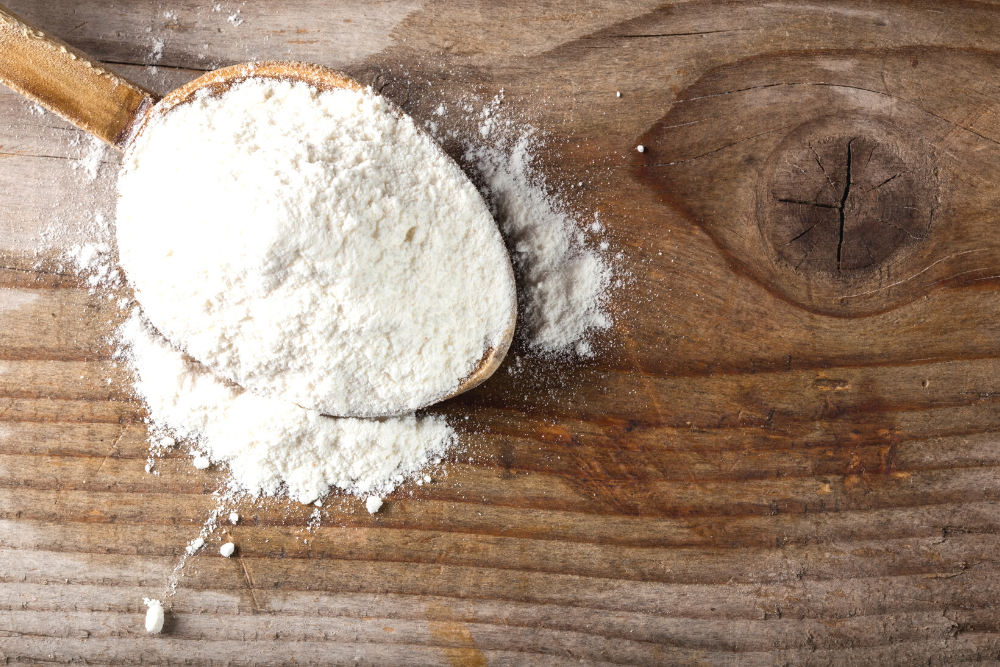
If you’re on a gluten-free diet, you know to avoid gluten, a protein found in wheat, rye, and barley. Yet, several products from trusted gluten-free brands contain an ingredient known as gluten-free wheat starch. In this article, I share how wheat starch is made, if it’s safe for people with celiac disease and non-celiac gluten sensitivity, and what brands use the controversial ingredient. This post may contain affiliate links. Please read my disclosures and disclaimers.
Every so often, a questionable ingredient or product comes to market, throwing the gluten-free community for a loop.
Just when you thought you figured out how to avoid products containing gluten, a protein found in wheat, rye, barley, and sometimes oats, a product comes to market that contains wheat in the form of an ingredient known as gluten-free wheat starch or Codex wheat starch.
In this article, I help you understand how gluten-free wheat starch is made, what products contain the controversial ingredient, and whether it’s safe for people with celiac disease and gluten intolerance to eat. The answer to the latter question isn’t as clear-cut as you might think.
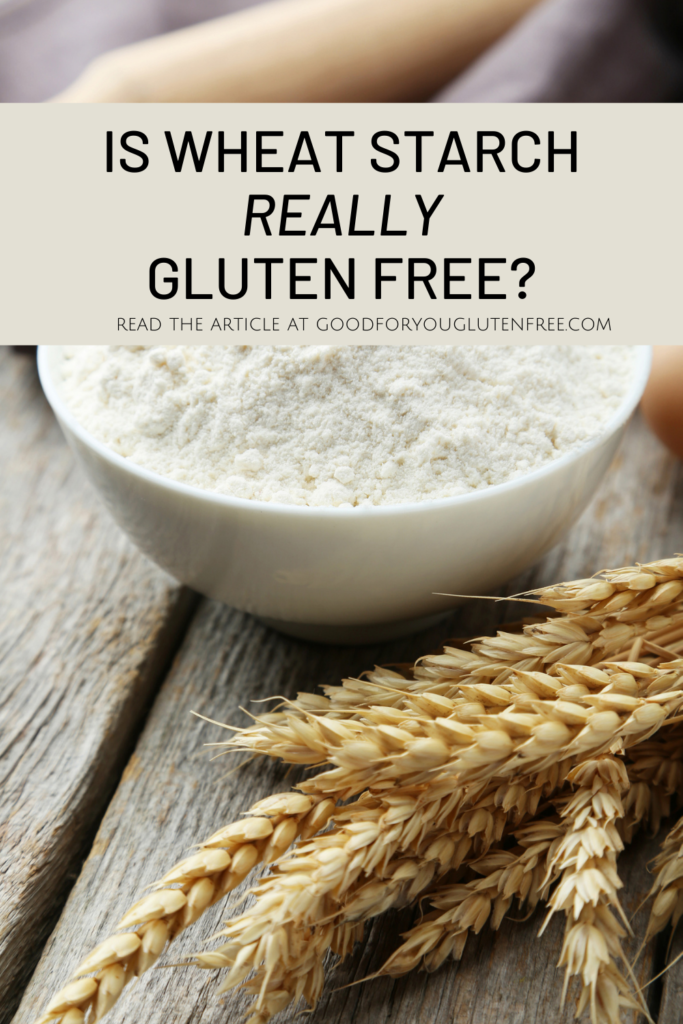
What is Wheat Starch?
Gluten-free wheat starch has been used in products throughout Europe and the U.K. for decades, but it’s a relatively new ingredient in the U.S.
Wheat starch is the actual starch extracted from wheat flour.
To turn wheat into wheat starch, milled flour is turned into a dough and then washed. During the wash, the starch dissolves in the water while the gluten sinks to the bottom of the container and remains solid. The liquid is then left to evaporate, and what’s left behind is a powdery substance known as wheat starch.
Wheat starch, when properly cleansed of gluten remnants, is considered gluten-free and safe for people on a gluten-free diet.
It’s often used as a thickening agent in cooking and baking, and Schär says it provides “durability” and “elasticity” to baked goods. Schär uses wheat starch in several of its gluten-free products.
Vital wheat gluten, on the other hand, contains only the gluten protein and is devoid of wheat starch. Many food companies and bakeries add bonus gluten to ensure their baked goods are extra stretchy and doughy.
What is Codex Wheat Starch?
While most manufacturers use the term “gluten-free wheat starch,” some list the ingredient as “Codex wheat starch.”
Codex refers to Codex Alimentarius, the governing body that oversees international food standards. The organization sets standards and provides guidance to food manufacturers to ensure food products made in one country are safe to consume in other countries.
When food manufacturers use the word “Codex” as an adjective to describe wheat starch, they tell consumers that the ingredient meets all international food guidelines set forth by the organization.
Wheat Starch and the FDA
The FDA allows wheat starch to be included in gluten-free labeled products as long as the gluten has been removed from the questionable ingredient (i.e., wheat) and the product has been tested and certified to contain less than 20 parts per million (ppm) of gluten.
Since gluten-free wheat starch meets the FDA’s criteria, food manufacturers can confidently label their products “gluten-free.”
Some products containing gluten-free wheat starch are also certified gluten-free by a third-party certifying organization, such as the GFCO.
In the U.S., food manufacturers must also abide by the Food Allergen Labeling and Consumer Protection Act of 2004, which requires manufacturers to disclose if their products contain any of the top eight allergens.
Wheat is one of the top eight allergens in the U.S.; therefore, you’ll see a “Contains Wheat” disclosure on the ingredient label of a product that contains wheat starch.
Should You Avoid Gluten-Free Wheat Starch?
As you can see, a product that is gluten-free isn’t always wheat free, and a product that is wheat free isn’t always gluten-free.
It may sound confusing, but it’s an important concept for the gluten-free community to grasp.
I explain this concept in detail in my article, Wheat Free vs. Gluten Free – What’s the Difference?
(1) Should You Avoid Wheat Starch if You Have Celiac Disease?
If you have celiac disease, your body reacts to the gluten protein in wheat, but it may not necessarily be reacting to wheat starch.
Therefore, most people with celiac disease can safely consume gluten-free wheat starch without issue.
(2) Should You Avoid Wheat Starch if You Have a Gluten Intolerance?
Gluten intolerance is a bit of a misnomer. Most people with gluten intolerance or sensitivity actually have a wheat intolerance or sensitivity.
This means that people with non-celiac wheat sensitivity might be reacting to various components of wheat, not just the gluten protein.
Researchers say people with non-celiac wheat sensitivity may experience an adverse reaction to other components of wheat in addition to gluten.
These components include α-amylase and trypsin (ATIs) inhibitors, lectins, and fermentable carbohydrates (FODMAPs), all of which can trigger symptoms.
The Wheat Zoomer test can help you identify if your immune system is making antibodies to wheat peptides in gluten and non-gluten components. Or you can conduct a good old-fashioned elimination diet, the gold-standard diagnostic tool for gluten intolerance.
(3) Should You Avoid Wheat Starch If You Have a Wheat Allergy?
If you have a wheat allergy, a condition that causes your immune system to overreact to wheat, you should avoid wheat starch, even if it’s labeled “gluten-free.”
People with wheat allergy often experience hives, rash, nausea, stomach cramps, nausea, and diarrhea after consuming wheat.
People with a severe wheat allergy may also experience anaphylaxis, a severe life-threatening reaction to an allergen. Again, remember that gluten-free does not equal wheat free!
Products that Contain Gluten-Free Wheat Starch
Several companies use gluten-free wheat starch, or Codex wheat starch, in their gluten-free labeled products.
These products are safe for people with celiac disease to consume but should be avoided by people with wheat allergies and cautiously used by people with gluten (wheat) intolerance.
Regardless of celiac disease or gluten intolerance, if you feel sick after eating wheat starch, it may mean your immune system is reacting to other components of wheat beyond the gluten protein.
Listen to your body by eating foods that feel good and avoiding foods that make you sick.
(1) Caputo
Caputo gluten-free pizza flour is manufactured by Antico Molino Napoli, an Italy-based company that makes gluten-y and gluten-free flours used by home bakers and restaurants. The flour blend contains gluten-free wheat starch.
The product is labeled gluten-free.
I tested the flour with my Nima Sensor, a portable gluten-detecting device, and Nima didn’t find any gluten. You can view the test results in this article.
I developed a gluten-free pizza recipe using Caputo flour. The crust came out spongy and doughy, and it was easy to handle without breaking. The pizza tasted and smelled authentic, likely because of the wheat starch.
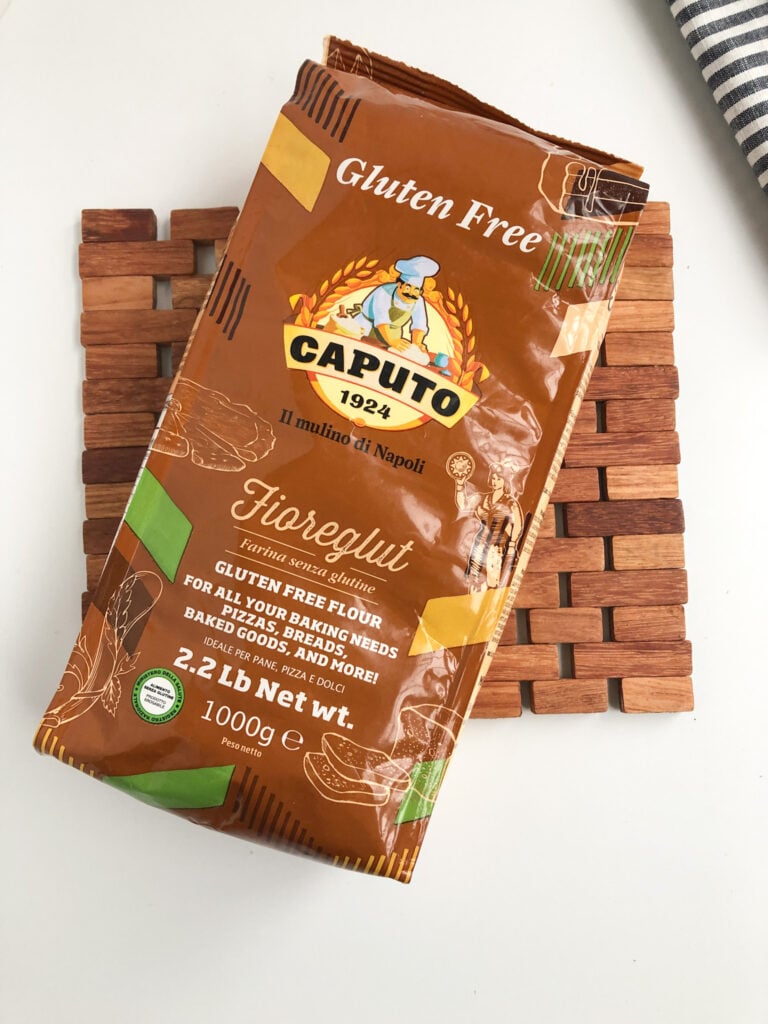
(2) DiGiorno
DiGiorno frozen pizza is another product sold in the U.S. that contains gluten-free wheat starch. DiGiorno’s original gluten-free pizza didn’t contain the controversial ingredient, but in 2021, the company reformulated its pizza recipe to add wheat starch.
I tested the DiGiorno pizza with my Nima Sensor, as shown below. A smiley face means Nima didn’t find any gluten.
While this product is safe for the gluten-free community, I was not too fond of how it tasted. There are better options, including Freschetta and Etalia, which I list in my Best Gluten-Free Frozen Pizza: Ranked and Tested.
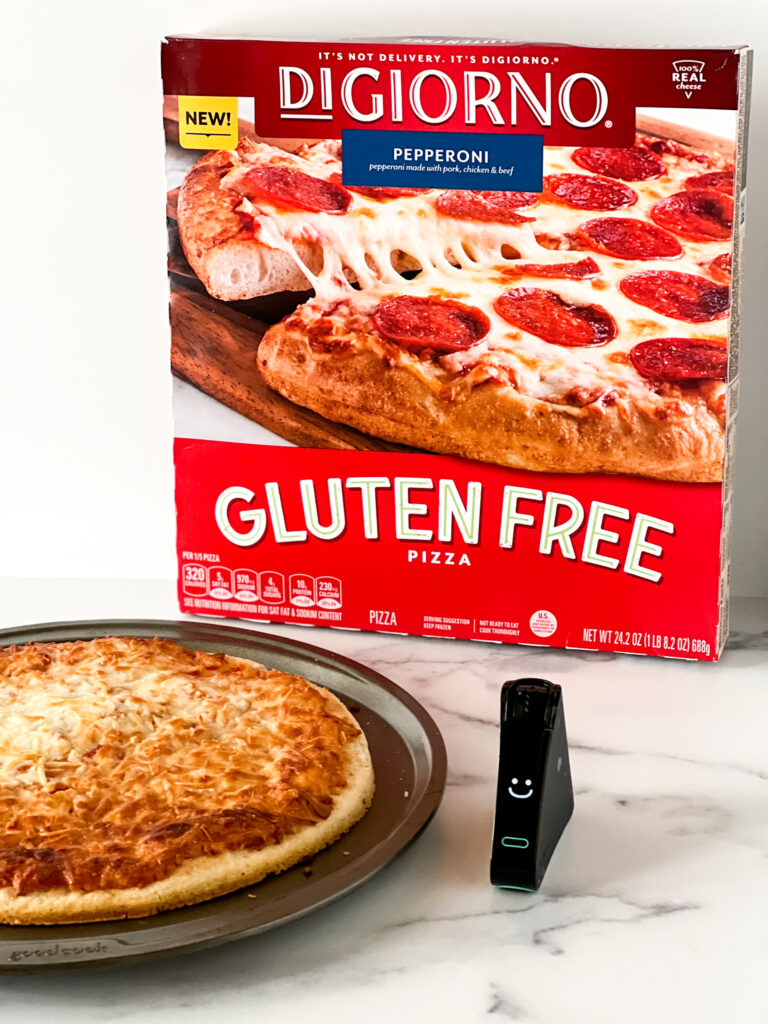
(3) King Arthur
King Arthur’s Gluten-Free Pizza Flour contains wheat starch that the company says has been processed to meet the Food and Drug Administration (FDA) requirements for gluten-free food.
IMPORTANT UPDATE!! An email from The Gluten Free Watchdog on August 17, 2023, states that King Arthur’s Gluten-Free Pizza Flour is NOT certified gluten-free by the GFCO.
Specifically, she said, “Contrary to some images from online merchants, discussion forums, and bloggers, GFCO does not currently certify King Arthur gluten-free pizza and bread flour containing wheat starch.”
But look at the following image. I took this image directly from the King Arthur website in April 2023, and you can clearly see the GFCO logo at the bottom of the product’s packaging.

After I read what the Watchdog said, I revisited the King Arthur website (August 17, 2023), and the company has a new image of the same product, this time showing a GF logo designed by King Arthur, not the GFCO label.
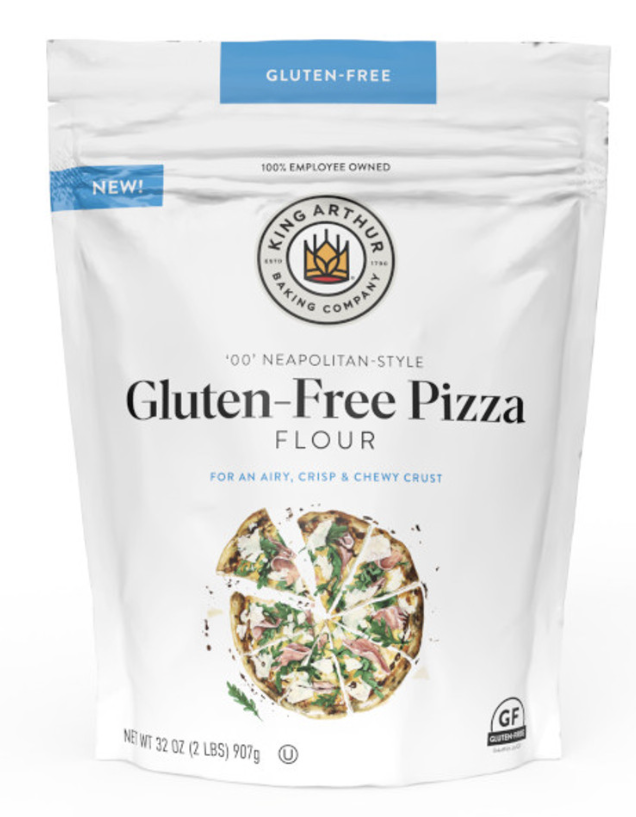
I asked King Arthur’s media team to explain what was going on and received a prompt reply confirming a few things:
(1) The King Arthur Gluten-Free Pizza Flour was indeed GFCO-certified when the product was launched in September 2022. It was sold as such through June 2023 before the company moved to new inventory with the gluten-free logo/label seen on the packaging today. (The Watchdog should have mentioned this important fact. Words are important.)

This is what the King Arthur gluten-free logo looks like. King Arthur created this design; it’s not a certification from a third-party agency.
(2) King Arthur says its gluten-free pizza flour is currently and always has been gluten-free according to FDA standards. While the product is no longer certified gluten-free by the GFCO, the company guarantees it meets the FDA’s Gluten-Free Guidelines.
(3) King Arthur says when it uses gluten-free wheat starch as an ingredient, it goes through additional testing in a certified lab using both the R5 ELISA Sandwich and R5 ELISA Competitive methods.
Once produced, the final products are tested again to ensure they contain less than 20 ppm of gluten, with a target of less than 10 ppm.
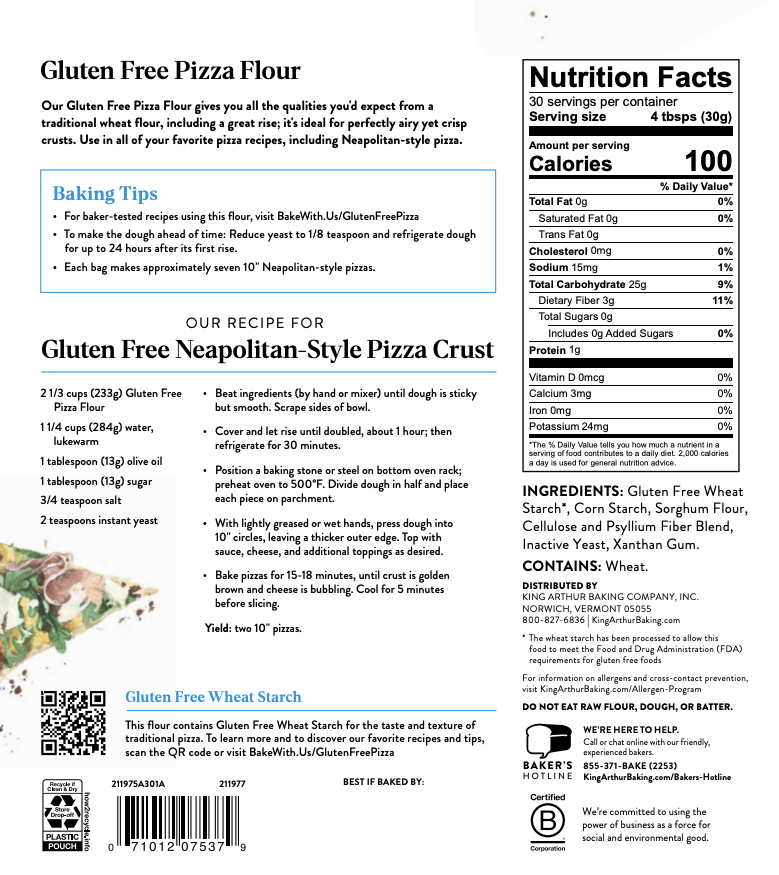
(4) Schär
Schär is one of the largest gluten-free brands in the world and the most popular gluten-free brand throughout Europe.
Its gluten-free croissants and pain au chocolat contain “certified gluten-free wheat starch.” You can find these frozen products online at the Gluten-Free Mall and select stores.
While I can’t find Schär croissants in my local grocery stores (they’re not sold in Colorado), I have had the pleasure of tasting the croissants. A chef at a hotel in Amsterdam served me warm, flaky, soft, and beautiful gluten-free croissants from Schär each morning.

(5) Original Sunshine
Original Sunshine is a brand of gluten-free flour made with gluten-free wheat starch. It’s sold to restaurants and businesses only (not available for consumer purchase).
I first discovered the brand when I was researching The Last Crumb, which contains Original Sunshine flour.
The luxury cookie brand released a gluten-free cookie collection in April 2023. One dozen cookies cost a whopping $160, and apparently, the collection sold out.

The Bottom Line
Gluten-free wheat starch is safe for people on a gluten-free diet to consume but should be avoided by people with wheat allergies and carefully considered by people with gluten (wheat) intolerance.
While few products contain the controversial ingredient, more manufacturers will likely add wheat starch to their products to improve the taste and texture of gluten-free baked goods.
I’m excited to see how the gluten-free market evolves and the role wheat starch will play in making gluten-free products taste, feel, and look better. But I worry about these products’ safety regarding people with wheat allergies and non-celiac gluten (wheat) sensitivities.
Would you consume a product that contains gluten-free wheat starch? Or maybe you already have? Leave a comment to share with your gluten-free friends.
More Reading
Please take a moment to read these articles too:
A friend told me about some youtube video showing how “gluten could be washed outof wheat flour making it safe”….So this site was the first I came upon that explained the science behind the claim. Personally I would not trust it, I have had typically bad reactions to even things that meet the FDA GF standard. If I want bread or cake, I will make it from scratch using alternative flours, not ones with “wheat starch”. I have started growing my own pseudo grains like Amaranth to grind…
I’m gluten intolerant and tried the gluten free DiGiorno pizza with the wheat starch and was so sick and miserable afterwards. I’ll stick with the cauliflower crust pizzas. They’re delicious and cause no problems.
I find more education needs to be available to the public regarding Celiac Disease. 20ppm’s is not low enough of a count for everyone and those newly diagnosed with Celiac Disease are mislead. Celiac Disease is a life-threatening Disease that when continually digested by a Celiac, can cause future health problems even if you don’t experience any symptoms.
I wonder if you also have a wheat allergy or intolerance. Thank you for sharing.
I get violently sick when I have eaten Schar products using GF Wheat Starch. I am celiac and no other products of Schar bother me except the ones using GF Wheat Starch. I guess I have an issue with it.
I’ll never trust wheat starch. I think it’s irresponsible for companies to use it and label products as GF.
Those Schar croissants are truly amazing! I’ve found them at Safeway in Portland, OR. Looking forward to trying the Caputo pizza!
Where to find GF wheat starch?? European sources?
I do not know but try Amazon maybe?
Do you have a source for GF wheat starch in the US? I cannot find it locally, only non-GF wheat starch.
Do you know of anywhere I can buy gluten free Wheat Starch in the states? It is often used in Chinese cooking and baking, but I haven’t found any labeled locally that are gluten free.
Glad I could help ❤️
Thank you for this article. If I had read wheat starch on a label I would not have felt safe eating it. But, after reading your article I would try it.
Thank you for sharing Sharon. Definitely hard to avoid gums.
I buy Schär gluten-free bread/buns/bagels and their pizza crusts, mainly because they don’t use gums in their products. They also taste great! If they should decide to use wheat starch in their US products, I’ll certainly try them.
So many gluten-free recipes call for xanthan gum, which upsets my stomach. I’ve learned to use alternatives when I’m baking, but store-bought gluten-free baked goods almost always contain xanthan gum or guar gum.